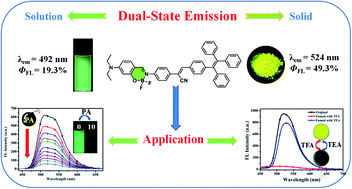Dual-state emission difluoroboron derivatives for selective detection of picric acid and reversible acid/base fluorescence switching†
Abstract
A novel difluoroboron derivative (TPEBF) containing α-cyanostilbene and tetraphenylethylene units has been designed and synthesized. TPEBF emits strong fluorescence both in dilute solutions (ΦFL = 19.3% in THF) and in the solid state (ΦFL = 49.3%), which is significantly distinct from the case of the aggregation-caused quenching (ACQ) and aggregation-induced emission (AIE) chromophores. The dual-state emission properties of the compound overcome the limitation of single-state luminescence and enable it to be used in both solid and solution states. TPEBF with strong emission in solution is utilized for sensing picric acid (PA) with high selectivity and sensitivity in THF (LOD = 497 nM) and aqueous media (LOD = 355 nM). The mechanism was described for the synergy of fluorescence resonance energy transfer (FRET) and photoinduced energy transfer (PET) based on the UV-vis absorption and fluorescence spectra, 1H NMR and theoretical calculations results. On the other hand, the highly efficient emission in the solid state allows the compound to be cast on paper to switch external acid/base stimuli.



 Please wait while we load your content...
Please wait while we load your content...